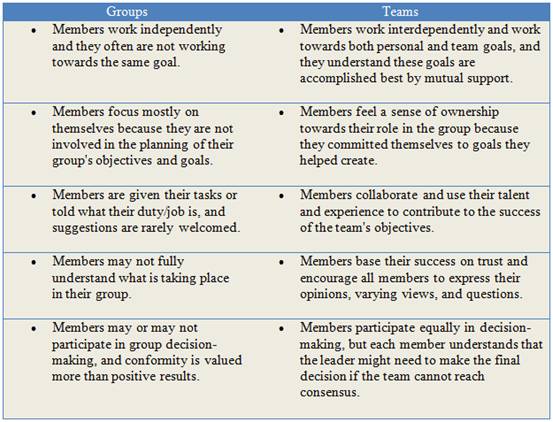Team theory
Characteristics of Effective Teams
A number of writers have studied teams, looking for the characteristics that make some successful. Larson and LaFasto looked at high-performance groups as diverse as a championship football team and a heart transplant team and found eight characteristics that are always present. They believe:
- The team must have a clear goal.
- The team must have a results-driven structure.
- The team must have competent team members.
- The team must have unified commitment.
- The team must have a collaborative climate.
- The team must have high standards that are understood by all.
- The team must receive external support and encouragement.
- The team must have principled leadership.
Larson and LaFasto in Teamwork: What Must Go Right/What Can Go Wrong (Sage Publications 1989).
There are some significant difference between an individual working as part of a group and an individual working as part of a team. Below is a list of the differences that exist between these categories.

Stages of Team Development
If you would prefer to view this interaction in a new web window, then please follow the link below:
R. Meredith Belbin is acknowledged as the father of team-role theory. He identified eight (later extended to nine) useful roles that are necessary for successful teams. His work gained in significance during the 1980s and 1990s with the widespread adoption of teamworking.
Teamworking is seen as a means of:
- Providing greater worker flexibility and co-operation
- Helping to achieve cultural shifts within an organisation
- Improving problem solving and project management
- Tapping the talents of everyone in the organisation.
There are many types of teams including cross-functional teams, top management teams, self-directed teams. Belbin's work concentrated on teams of managers. The essence of his theory developed in Team Roles at Work is that, given knowledge of the abilities and characteristics of individual team members, success or failure can be predicted within certain limits. As a result unsuccessful teams can be improved by training and changing roles.
A Team Role came to be defined as:

A tendency to behave, contribute and interrelate with others in a particular way.
R. Meredith Belbin

Read more about Belbin's Team Roles at Work (you can do this in the window below or follow the previous link to read the article in a separate window) and then consider answers to the questions below.
You may like to look at the following practical analysis of Belbin's team roles on the Mind Tools site.

Question 1
Briefly summarise the nine team roles identified by Belbin.
Question 2
Explain why 'balance is the key' as far as Belbin is concerned.
Extension:
- Consider a team of which you are a member (this might be teams you have worked with in class). Use Belbin's model to analyse this team
- Over a period of time, observe the individual members of your team, and see how they behave, contribute and behave within the team.
- Now list the members of the team, and for each person write down the key strengths, and characteristics you have observed.
- Compare each person's characteristics with the Belbin's descriptions of team-roles and decide which of the roles most accurately describes that person.
- Once you have done this ask another member of the team to carry out the same exercise and compare your results - are they similar?
Questions
- How easy is it to assign a role to an individual?
- Do team members have a range of characteristics which make them difficult to categorise?
- Do you believe it would be possible to train individuals to overcome weaknesses they have in terms of team requirements?
- Can you find alternative studies that categorise individual characteristics within teams?